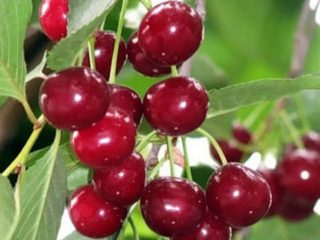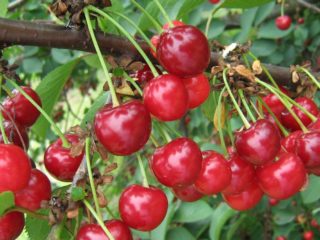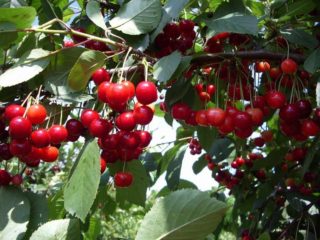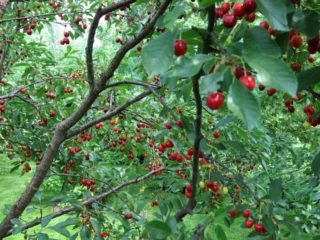Content
Summer is a great time, because it gives not only warmth and the rays of the bright sun, but also a bountiful harvest. One of the interesting and unpretentious plants is the Minx cherry. The berry is popular among summer residents, because it has unique properties and an unusual biochemical composition.
Description of minx cherries
Cherry variety Duke Minx was entered in the State Register in 1997. From its predecessors, the plant inherited a high degree of yield and good qualities of the fruits themselves.
According to statistics, judging by the description of the variety and reviews, every second gardener chooses the Minx cherry. They give preference to this particular plant because of its attractiveness. The berry has a stable yield and pleasant taste. The culture is classified as mid-season, and the ripening time of the fruits depends on climatic conditions.
Grows best in the North Caucasus region. The Shalunya cherry became widespread in Ukraine. But some summer residents manage to grow it in the south of Siberia.
Height and dimensions of an adult tree
The tree grows at a fast pace. Its height does not exceed 3-4 m. It has a spreading and dense crown. Shoots resemble straight lines, but not thick lines. Flowers are formed on bouquet branches. The leaves are distinguished by a rich dark green shade and a rounded elongated shape with a pointed tip. The leaf edge has small denticles.
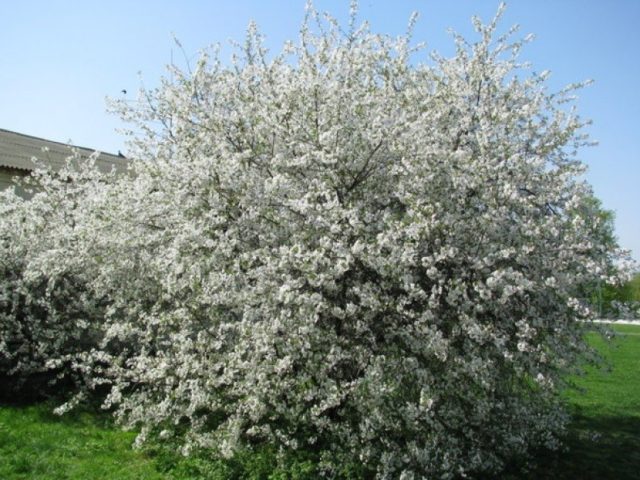
Cherry Duke Minx belongs to hybrids
Description of fruits
Cherry variety Minx is characterized by the presence of one-dimensional fruits, the weight of which does not exceed 6 g. The berries are distinguished by a round and compressed shape. Covered with shiny smooth skin.
If we talk about the color of the fruit, they are usually burgundy. With prolonged exposure to sunlight, they acquire a black tint. They can fall off on their own if they become overripe, but this does not always happen. The pulp is considered juicy. Has a reddish tint and sweet and sour aftertaste.
This variety is suitable for making jam, jam or compote. The fruits are enriched with vitamins and minerals in the form of folic acid, iron, copper, magnesium and phosphorus.

The fruits grow large, bright and juicy, delicious jam, jam and compote are obtained from the berries, you can also eat fresh, because the berry is rich in sugar
The berries are not firmly held on the stem, so gardeners quickly harvest. The fruits are highly resistant to frost. Up to 15-30 kg can be harvested from one tree. Tasting taste score - higher than 4.8 on a 5-point scale.
Pollinators for minx cherries
Cherry Minx is included in the category of self-fertile varieties. Some types of cherries are considered the best pollinators - Chernokorka, Samsonovka, Valeria Chkalova and Vinka cherry. Plants can be planted within a radius of 40-50 m. But the closer the pollinator is to the tree, the higher the likelihood of fruiting.
Main characteristics
According to numerous reviews, it can be concluded that the Minx cherry variety is considered an example of horticultural culture. The plant is of high quality and versatile. It is distinguished by its unpretentiousness and endurance to the effects of adverse factors.
Drought resistance, frost resistance
Cherry Minx is considered a winter-hardy crop. But there are several restrictions on growing. At temperatures up to 26 degrees, the shoots and the tree itself do not freeze, but more than 50% of the buds in flower buds die. With frosts in spring, no more than 30% of the buds of a plant freeze out, so this variety is not always good for cold conditions.
The Minx cherry quickly adapts to prolonged lack of water, so the tree can be planted in areas prone to drought. Also, this variety is resistant to fungi that cause coccomycosis and moniliosis.
Yield
The Minx cherry ripens towards the end of June. The first crop can be harvested as early as 3 years after planting the tree. If you take care of the plant and comply with all agrotechnical requirements, then in 5-6 years the yield from one tree will grow to 10-15 kg of fruits. After 10 years, you can collect up to 35-40 kg of berries.
Advantages and disadvantages
Summer residents exhibit a lot of information with photos and descriptions about the Minx cherry variety. And this is not without reason, because this berry, unlike others, has many positive qualities in the form of:
- the presence of large fruits that have a good presentation;
- excellent taste with fresh berries;
- high quality processed products;
- high degree of productivity;
- frost resistance;
- drought tolerance;
- the presence of immunity to diseases of a fungal nature.
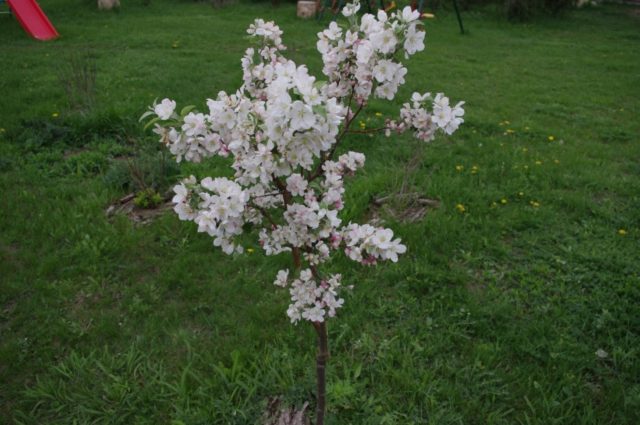
The tree has an average height, which is a definite plus.
Despite all the advantages, the Minx cherry has one main drawback - the plant cannot self-pollinate.
Landing rules
In order for the tree to bear fruit, all conditions must be met when planting. Timing, the correct choice of place and the subtleties of the process are important.
Recommended timing
In regions with suitable conditions, minx cherries can be planted in spring or autumn. If the summer resident chooses the second option, then it is recommended to cover the seedling on top with a material that allows air to pass through. When planting a plant in the northern regions, it is better to choose the first option.
Site selection and soil preparation
To plant the Minx cherry correctly, you need to correctly choose a place for it.
There are several conditions:
- Cherries are placed on an area of 3 * 4 m.
- It should be well lit by the sun's rays. To do this, you need to plant a tree in the southern part of the site.
- Groundwater should not be located closer than 1.5-2 m to the root system. If the ground is very wet, then the plant will freeze and will not bear fruit.
- The soil should be loamy or sandy loam.
Compliance with all the recommendations will help the tree quickly take root.
How to plant correctly
Planting a tree also needs to be done correctly. Experienced summer residents give several recommendations:
- Before planting a seedling, it is carefully examined. If there are damaged, diseased or dry roots, then they are removed. Skeletal branches are shortened. Then you need to dig a hole, the depth of which is 0.5-0.6 m.
- Before burying the roots, the soil is mixed with humus, superphosphate and potassium chloride. The root collar should rise 5-7 cm from the ground.
- After the tree is installed, the soil is compacted, filled with 2-3 buckets of water. The settled soil is irrigated and mulched with a layer of compost or sawdust.
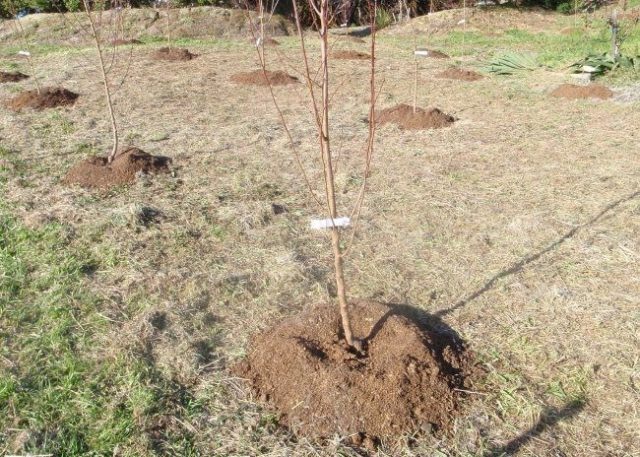
If a gardener plants several trees at once, then the distance between them is at least 3 m
How to care for minx cherries
Cherry Minx needs care. It is periodically necessary to loosen the soil and remove weeds in a timely manner. Also, experienced gardeners regularly prune twigs.Excess and weakened parts of the tree are removed in early spring.
Proper maintenance also means good soil condition. If the soil is too acidic, then every 5 years it is recommended to fill it with lime mortar.
Care also means protecting the plant from the development of various diseases. Although the Minx cherry is resistant to fungi, it must be inspected constantly. For prevention, you can use Bordeaux liquid or a solution of copper sulfate. Before flowering, the plant is recommended to be treated with a special preparation Speed.
Watering and feeding schedule
From the photos taken by gardeners and the description of the variety, it can be seen that the Minx cherry does not belong to whimsical crops. But watering the soil near the tree is still necessary at a certain time. Usually, 4 waterings per summer are enough for this plant.
The first watering is carried out after the cherry blossoms. The second time you should water the roots during the period of active growth of the ovary. The next watering is recommended after harvest, and the last procedure is carried out at the end of October.
You need to start feeding the minx cherries 1-2 years after planting. Manipulations are carried out in early spring and September. At the beginning of the new season, rotted compost, ammonium sulfate and ammonium nitrate are used. Potassium chloride and superphosphate are added in autumn. But it is worth remembering one rule - an excess of mineral fertilizers can also negatively affect the plant.
Pruning
The first pruning is carried out when planting a seedling. Lateral shoots are shortened to buds. The next treatment is carried out after 1-2 years.
6-8 years after planting the Minx cherry, the main branches dry out. They should also be cut off. Before this, it is necessary to prepare strong root shoots.
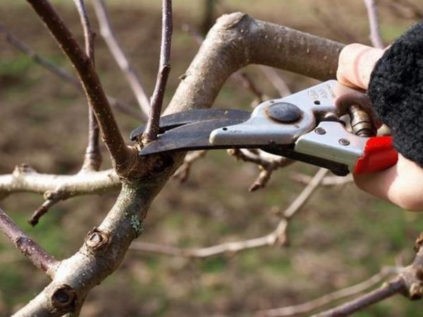
Pruning is one of the mandatory and regular procedures.
The process allows you to prevent an increase in crown density, increase the quantity and quality of berries, and extend the life of the plant.
Preparing for winter
To increase the survival rate of the Minx cherry, it is necessary to properly prepare it for winter. Once all the foliage has fallen, gardeners perform a sanitary removal of the dry and lateral branches. If cracks have formed on the crown of the tree, then it is necessary to lubricate them with pitch.
The hole where the bush is planted is dug up and mulched with compost or sawdust. The barrel is covered with a solution of lime, copper sulfate and PVA glue. After the first frosts have passed, the bush is sprayed with 5% urea. To prevent the plant from freezing, it is covered with warm non-woven material for the winter. You should also protect the underside of the tree from rodents. To do this, you need to put on covers made of durable fabric.
Diseases and pests
Cherry Minx is highly resistant to major stone fruit diseases. This variety rarely suffers from dangerous fungal diseases in the form of coccomycosis and minoliosis.
If we talk about the influence of rodents, then in the winter period, it is recommended to protect the bark using traditional methods.
Conclusion
Cherry Minx is one of the unpretentious plants to care for. It produces tasty and large fruits. Berries can be eaten fresh or processed into jam, jam or compote. Despite the abundance of positive qualities, planted trees need appropriate care. It is necessary to regularly prevent diseases, protect the bark from pests, and fertilize the soil. If you follow all the recommendations, then the gardener will get a good harvest for a long time.
